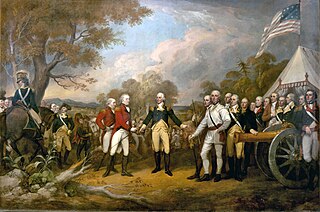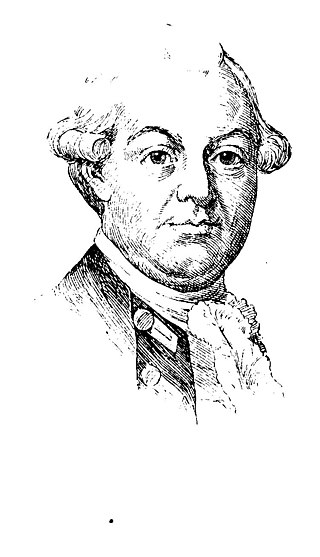
The Battle of Bennington was a battle of the American Revolutionary War, part of the Saratoga campaign, that took place on August 16, 1777, on a farm in Walloomsac, New York, about 10 miles (16 km) from its namesake, Bennington, Vermont. An American force of 2,000 men, primarily New Hampshire and Massachusetts militiamen, led by General John Stark, and reinforced by Vermont militiamen led by Colonel Seth Warner and members of the Green Mountain Boys, decisively defeated a detachment of General John Burgoyne's army led by Lieutenant-Colonel Friedrich Baum, and supported by additional troops under Lieutenant-Colonel Heinrich von Breymann.

The Battles of Saratoga marked the climax of the Saratoga campaign, giving a decisive victory to the Americans over the British in the American Revolutionary War. British General John Burgoyne led an invasion army of 7,200–8,000 men southward from Canada in the Champlain Valley, hoping to meet a similar British force marching northward from New York City and another British force marching eastward from Lake Ontario; the goal was to take Albany, New York. The southern and western forces never arrived, and Burgoyne was surrounded by American forces in upstate New York 15 miles (24 km) short of his goal. He fought two battles which took place 18 days apart on the same ground 9 miles (14 km) south of Saratoga, New York. He gained a victory in the first battle despite being outnumbered, but lost the second battle after the Americans returned with an even larger force.

The Continental Army was the army of the United Colonies representing the Thirteen Colonies and later the United States during the American Revolutionary War. It was formed on June 14, 1775, by a resolution passed by the Second Continental Congress, meeting in Philadelphia after the war's outbreak. The Continental Army was created to coordinate military efforts of the colonies in the war against the British, who sought to maintain control over the American colonies. General George Washington was appointed commander-in-chief of the Continental Army and maintained this position throughout the war.

The Saratoga campaign in 1777 was an attempt by the British high command for North America to gain military control of the strategically important Hudson River valley during the American Revolutionary War. It ended in the surrender of the British army, which historian Edmund Morgan argues, "was a great turning point of the war, because it won for Americans the foreign assistance which was the last element needed for victory."

Simon Fraser was a British general during the American War of Independence. He was killed in the Battle of Bemis Heights during the Saratoga Campaign. The shot that killed Fraser is often attributed to Timothy Murphy, of Daniel Morgan's Rifle Corps, which was assigned to the Left and under the command of Benedict Arnold, who was leading Morgan's men as well as Dearborn, Cilley, Poor, and the rest of the American left wing, which was attempting to push back the reconnaissance in force led by Simon Fraser on the Barber Wheatfield.

Enoch Poor was a brigadier general in the Continental Army during the American Revolutionary War. He was a ship builder and merchant from Exeter, New Hampshire.
Ebenezer Learned was a brigadier general in the American Continental Army during the Revolutionary War.

The 1st Rhode Island Regiment was a regiment in the Continental Army raised in Rhode Island during the American Revolutionary War (1775–83). It was one of the few units in the Continental Army to serve through the entire war, from the siege of Boston to the disbanding of the Continental Army on November 3, 1783.

Woodbridge's Regiment of Militia, also known as the "1st Hampshire County Militia Regiment" and "Woodbridge's (25th) Regiment" and "The 25th Regiment of Foot". On April 20, 1775, the day immediately following the Battles of Lexington and Concord, Woodbridge's regiment was formed and marched to Cambridge, Massachusetts near Boston, and participated in the siege of Boston and the Battle of Bunker Hill.
Sparhawk's Regiment of Militia, also known as the 7th Worcester County Militia Regiment. The Regiment took its name from its commander, Col. Nathan Sparhawk. The regiment spent the winter of 1776–1777 with Gen. George Washington's main army at Morristown, New Jersey. The regiment was again called up at Barre, Massachusetts on August 16, 1777, as reinforcements for the Continental Army during the Saratoga Campaign. The regiment marched quickly to join John Stark at Bennington, Vermont and then to General Horatio Gates at Saratoga, New York as he faced British General John Burgoyne in northern New York. The regiment served in General Warner's brigade. With the surrender of Burgoyne's Army on October 17 the regiment was disbanded on October 18, 1777.
Jonathan Chase was a soldier in the American Revolutionary War.
Latimer's Regiment of Militia was called up at Windham, Connecticut and made up of men from Windham, Tolland and New London Counties on 23 August 1777 as reinforcements for the Continental Army during the Saratoga Campaign. The regiment, under Colonel Jonathan Latimer, marched quickly to join the gathering forces of Gen. Horatio Gates as he faced British Gen. John Burgoyne in northern New York. The regiment arrived on 10 September 1777 and was attached to General Poor's brigade. It participated in the fighting on Freeman's Farm on 19 September, and at Bemis Heights on 7 October. Later, it took part in the pursuit of Burgoyne's army. With the surrender of Burgoyne's Army the regiment was disbanded on 10 November 1777.
The Van Alstyne's Regiment of Militia, also known as the 7th Albany County Militia Regiment, was called up in July, 1777 at Kinderhook, New York to reinforce Gen. Horatio Gates's Continental Army during the Saratoga Campaign. The regiment served in Brigadier General Abraham Ten Broeck's Brigade. With the defeat of General John Burgoyne's British Army on October 17, 1777, the regiment stood down. It is uncertain whether the regiment participated in the October 7 Battle of Bemis Heights, and if it did, whether the entire regiment was there.

The North Carolina Line refers to North Carolina units within the Continental Army. The term "North Carolina Line" referred to the quota of infantry regiments assigned to North Carolina at various times by the Continental Congress. These, together with similar contingents from the other twelve states, formed the Continental Line. The concept was particularly important in relation to the promotion of commissioned officers. Officers of the Continental Army below the rank of brigadier general were ordinarily ineligible for promotion except in the line of their own state.
The northern theater of the American Revolutionary War also known as the Northern Department of the Continental Army was a theater of operations during the American Revolutionary War.
McAlpin's Corps, also known as McAlpin's Corps of Royalists and the American Volunteers, referred to either of two loyalist units in the British Army, in British Canada, commanded by Major Daniel McAlpin, during the American Revolutionary War. In most instances, the name described the American Volunteers, a corps of American Loyalists, who served in the 1777 Burgoyne Expedition, of the Saratoga Campaign. The term was also used, at times, to refer to a 'battalion' put under the command of McAlpin, in 1779, formed from the remnants of General Burgoyne's several loyalist corps, including the "American Volunteers", the King's Loyal Americans, the Queen's Loyal Rangers, and Adams' Rangers.

Events from the year 1777 in the United States.

The British Army during the American Revolutionary War served for eight years in the American Revolutionary War, which was fought throughout North America, the Caribbean, and elsewhere from April 19, 1775, to September 3, 1783. The war formally commenced at the Battles of Lexington and Concord in present-day Massachusetts. Two months later, in June 1775, the Second Continental Congress, gathered in the revolutionary capital of Philadelphia, appointed George Washington to organize patriot militias into the Continental Army and lead them in a war against the British Army. The following year, in July 1776, the Second Continental Congress, representing the Thirteen Colonies, declared themselves free and independent from colonial governance.









